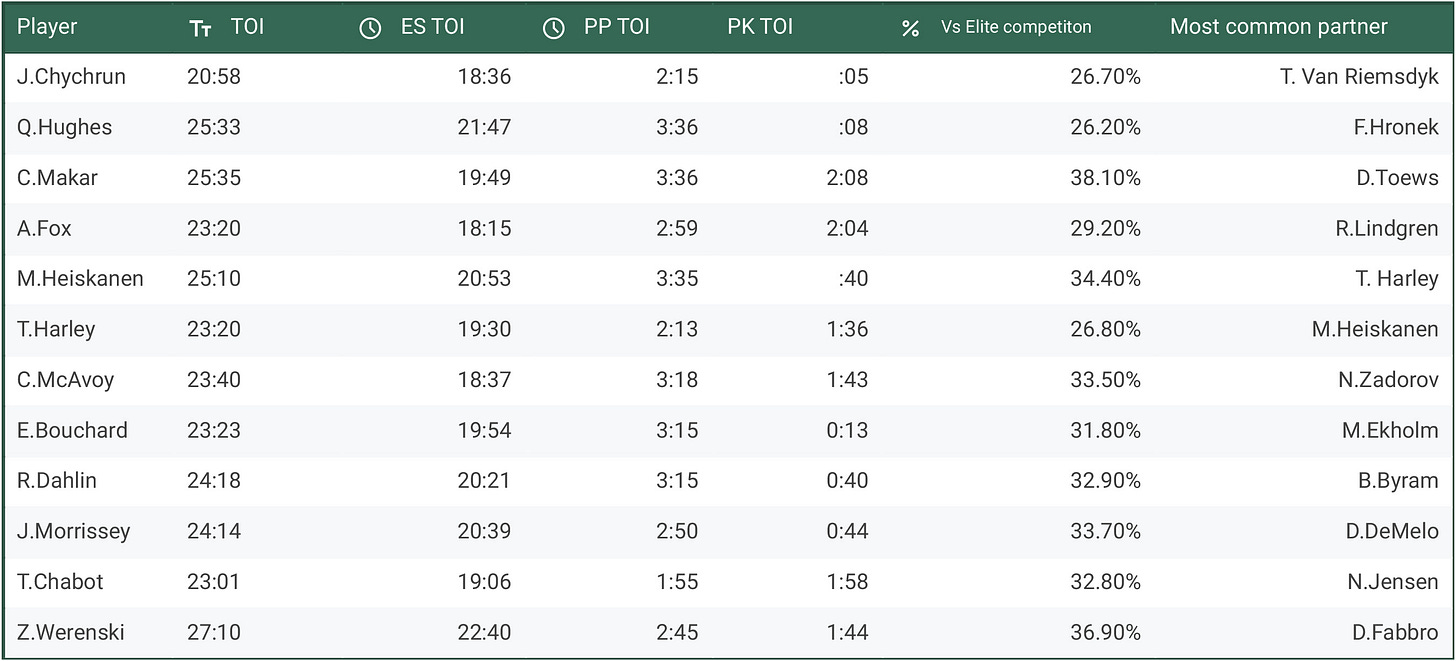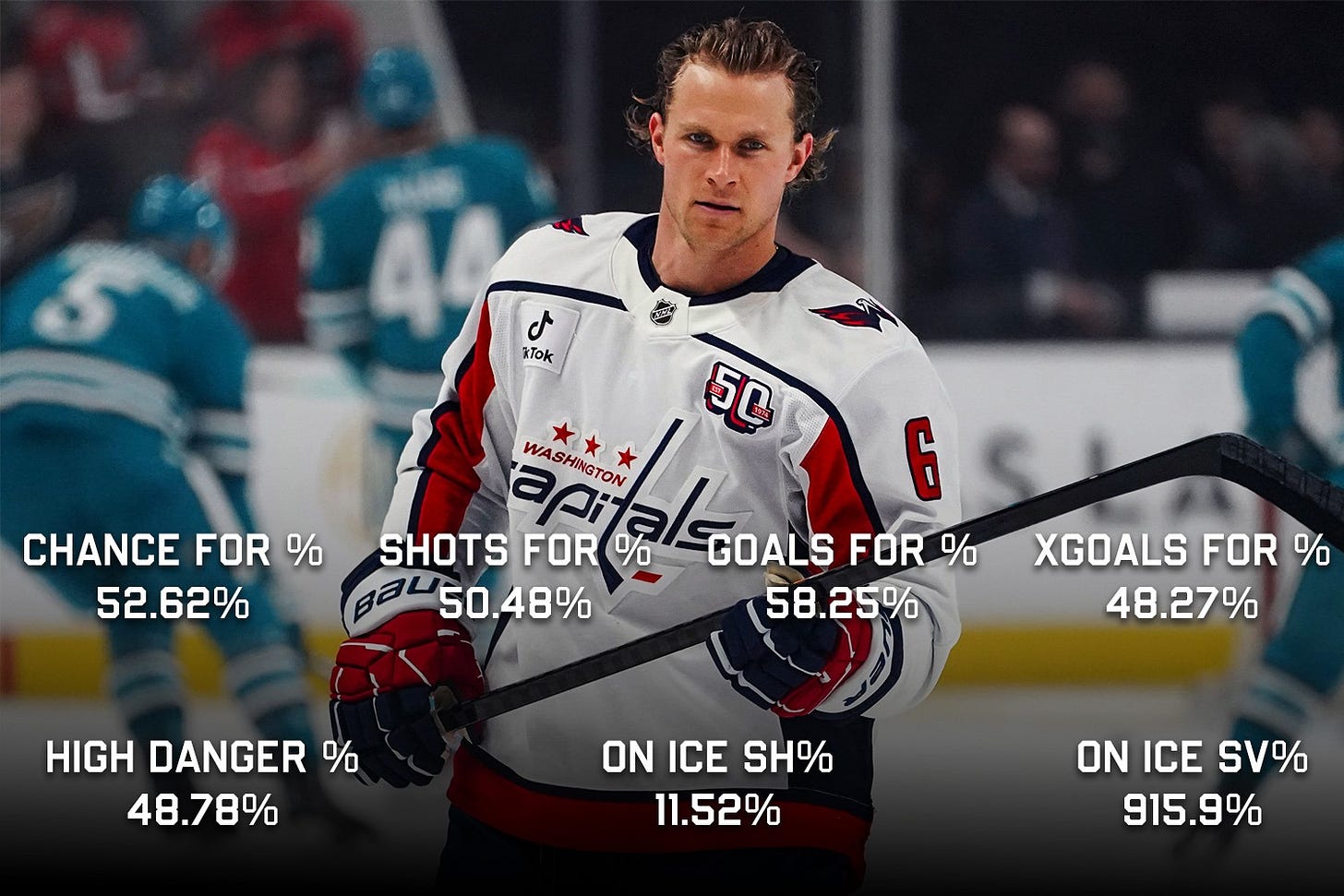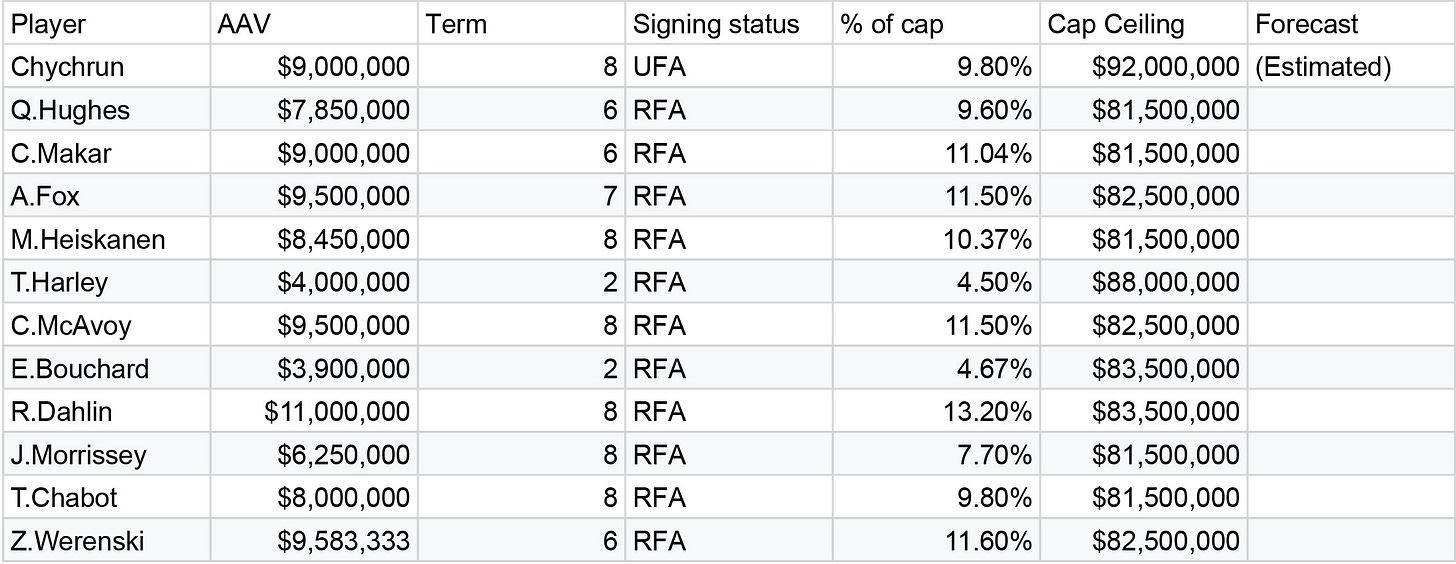What the Jakob Chychrun extension means for defenseman going forward
Raw Milk and candles aren't cheap
Just a decade ago, the Norris Trophy Winner for the NHL’s “best all around defenseman,” Duncan Keith of the Chicago Blackhawks took home the award with 61 points. That’s how quick the landscape of a position can change when a league wholesale recognizes an inefficiency in roster construction. It wasn’t overnight and there are some organizations more willing than others to take adventurous swings, but make no mistake about it, the era of the offensive defenseman as the league standard is here.
Two weeks ago the Washington Capitals locked up left-handed defenseman Jakob Chychrun to a market setting eight year deal worth $9 million per season. Chychrun is a player whose underlying results have traditionally lagged behind his counting stats that is having a career year on a Capitals team that’s been one of the league’s best stories this year.
There are no better market conditions for a player than a walk year, rising salary cap and an evolution within the league. Now, someone of Chychrun’s physical skills likely would’ve gotten a chance ten or 15 years ago, but the offense first leaning defensemen that make up his contemporaries are harder to envision in a heavier, slower league that was dominated by the Chicago Blackhawks and Los Angeles Kings.
Some NHL teams and media figures might bemoan the lack of physicality on the back-end and what it means to the culture of the sport, but teams slowly but surely discovered an inefficiency. You used to turn on NBCSN to watch rivalry night to hear Mike Milbury and Keith Jones refer to any defenseman that couldn’t handle the puck as a “defensive defenseman,” because they didn’t generate offense, but they blocked shots and killed penalties.
Now, we’ve reached an inflection point where adequate puck skills, regardless of a player’s size, are a prerequisite for a Stanley Cup caliber defensive core. Teams clinging to the outdated archetype for the position are in danger of being left behind and it's largely rooted in traditional thinking. That just because a defenseman was always built or played a certain way, that’s why it needs to stay that way.
As far as the Capitals newly extended defenseman, Chychrun is a player who’s impact jumps out through the TV. The former first round pick is a gifted skater with a heavy shot that jumps out every single time he’s on the ice. He’s an 84th percentile top skate speed skater and 91st percentile player in shot speed according to NHL Edge.
The defenseman is a fascinating litmus test in the eye-test vs analytics debate that perpetually rages in the shadows while talking heads argue if LeBron James or Michael Jordan is the greatest basketball player of all time. In hopes of finding a deeper understanding, the two sides are engaged in a permanent stalemate like The Joker and Batman.
Proponents of the eye test fail to see that their evaluations largely stem from their own life experiences and what they value. Analytics believers don’t account for the human factor in their decision making. In an ideal world, these two parties would work together in conjunction to develop well rounded and deeper understandings of a player or team.
In the case of Chychrun, he presents a straightforward question: What is a number one defenseman in the contemporary NHL and how much is that worth per season?
The Context
In understanding any player’s performance, the single most important factor to consider is usage. In terms of ice time, quality of competition, common line mates, the responsibilities associated with where you play in the lineup and the reputation you have with your coach all put together a profile for understanding.
It’s not a coincidence that NHL players typically put together career years around when they’re pending unrestricted free agents because that’s when they’re close to their maximum credibility. At that point, the player is pushing 27 years old or has 7 years of experience and likely has endeared a meaningful level of trust from decision makers.
NHL players typically reach their peak ice time in their late 20s because this is when they’ve reached the highest point in the relationship between performance and track record. NHL coaches are amongst the most risk averse in all of sport which leads to younger players getting slow rolled on a methodical march up the lineup over the course of the several seasons unless it’s a particularly high end, transformational prospect.
At 26 years old, Chychrun has as much cachet as he’s ever had in as a professional hockey player. The Capitals went out and acquired him this past offseason as a means of shooting an average team in the arm with some real juice. When it comes to usage, Chychrun has carved out a pretty favorable role in his first year as a Capital.
In comparison to Chychrun’s contemporaries, he plays the fewest overall minutes and the second least at five on five, has the second most favorable matchups in terms of quality of competition and plays most often with Trevor Van Riemsdyk, a partner with a track record of suppressing opponent’s offense.
So, on just a usage and context basis, Chychrun doesn’t really fit in this box of number one defenseman. Understanding how a player is used provides context to a team’s expectations for said individual. A team wouldn’t hide someone from more responsibility if they could handle it. It’s not a coincidence that the three most heavily used defenseman on a per game basis this season are the consensus Norris Trophy front runners in Quinn Hughes, Cale Makar and Zach Werenski.
That said, the Capitals still use Chychrun slightly less than franchise legend and possible hockey hall of famer John Carlson. It’s reasonable to assume that at 35 years old, Carlson doesn’t have a ton of hockey left in him, and Chychrun was at least in part extended to fill that void when the time does come.
Sure, in an ideal world if Chychrun is going to be a franchise defenseman, a team would like him to play more minutes and soak up minutes against the better part of opposing lineups. In Washington’s case, they’ve been afforded the luxury of not needing more from Chychrun in the present, though that will change in due time.
The counting stats and sustainability
In 67 games so far this season, Chychrun has already tied his career high in goals and set a new career high in points. The funny thing is, Chychrun is setting these career highs in counting stats in spite of the fact he’s playing almost 90 seconds fewer per game this year vs last year in Ottawa and on pace to finish with the exact same number of shots on goal as last season.
In a vacuum, with such a stark reduction in minutes, especially 30 seconds fewer of power play time per game, would likely mean a dip in counting stat production. Instead, Chychrun has offset that reduction in ice time with a higher shooting percentage and more successful overall plays.
For Chychrun’s career, the defenseman is a 7.3% shooter, so his 10.8 shooting percentage definitely trips the outlier meter. For context, if Chychrun shot his career average this season, on the number of shots on goal recorded so far, he’d have scored 12 goals, which although well above average for his position, wouldn’t put him in elite company with players like Makar, Hughes and Werenski.
Determining sustainability in environmental changes is not an exact science. Chychrun’s previous performance isn’t necessarily indicative of future production, but it does give a range of potential outcomes. The Capitals as an organization are banking on their environment being the reason Chychrun is having a career year at 26 as opposed to just simply having better shooting luck.
The best way to determine sustainability of offense comes down to how translatable or sticky the results are. Generally speaking, players that are on the ice for more scoring chances than their opponents create in their minutes win their minutes. The more winning minutes a team can string together, the more likely they are to go on and win the game.
In Chychrun’s case, his underlying numbers paint an interesting picture.
Amongst the cohort of who are considered an elite defenseman, Chychrun’s underlying numbers stick out like a sore thumb. Though his quantity of scoring chances for as well as his shot on goal share are positive, meaning the Capitals have more than their opponents, the quality of chances against show a player that is conceding dangerous offense against.
What’s equal parts impressive and concerning if you’re the Capitals is that Chychrun is massively outperforming his underlying numbers. In Chychrun’s minutes, the Capitals are conceding 51.73% of the expected goals and 51.22% of the high danger chances against.
So, in Chychrun’s minutes, the Capitals are scoring 58.25% of the goals, while spending considerable time in their own end defending high quality chances. That is a difficult recipe to replicate over time and puts increased pressure on the team’s goaltending to meet the moment.
It’s not necessarily disqualifying for a player to outperform their metrics, but it does raise a question of sustainability. For example, if one were to role a single die and win on a 1, 2, 3 or 4 and the opponent were to win on a 5 or 6, the latter could still win, but it would be harder to do in the long run.
The 2024-2025 season will be Chychrun’s first with a positive goal share since 2022-2023, but his metrics aren’t all that dissimilar from his previous seasons. That means that in all likelihood, Chychrun’s production is a perfect storm. It doesn’t mean he isn’t an effective player, but it does raise questions to how replicable this career year actually is going forward.
If the Capitals are banking on Chychrun eventually assuming Carlson’s role as the team’s number one defenseman, the team expects him to be a positive contributor at both ends. As of right now, it seems more like Chychrun is a high variance player where his physical tools enable him to outperform his metrics, but with time, his skating will erode.
When evaluating his defensive game, it’s important to understand him within the context of his role and assignment. If the Capitals deploy Chychrun with the mindset of him tilting the ice in favor of the team’s best offensive players, it’s a willing tradeoff that he concedes a bit more defensively. It’s not a coincidence that Chychrun’s most common forwards this season are Dylan Strome and Alex Ovechkin, meaning the Capitals are actively putting him in offense first situations and okay with conceding defensively.
In the context of the contemporary NHL defenseman, transition stats are a differentiation point. There are plenty of blue liners around the league that have wicked shots and skate well, but defenders that can actively facilitate transitioning from defense to offense, with possession of the puck are a true premium asset and have a strong influence in a team’s offensive game even if they don’t end up producing a goal or assist.
In Chychrun’s case, he stands out as the Capitals’ best transition defenseman. Chychrun averages the highest rate of defensive zone exits with possession, passed zone exits and the second highest rate of puck retrievals. All of those in conjunction with each other paint a picture of a mobile, strong puck mover that gets his team out of the defensive zone at a high rate with great efficiency.
The Rising Salary Cap
At face value, Chychrun’s sticker price is a bit jarring. In the greater salary conversation, a majority of players in their respective primes have collectively had their earning’s potential artificially depressed. The COVID-19 pandemic’s impact on the league’s economics over the last five years is an inescapable reality.
Chychrun doesn’t fit in this cohort of what would be considered the elite tier of the position, but his new contract is a reflection of where the league’s revenues are going. The NHL is projecting increased revenues over the next several seasons which would then coincide with a higher cap ceiling. This in turn means that a player’s cap hit will be a smaller percentage of the cap over time and in turn making them more cost effective.
While it’s also unrealistic to expect for an increasing cap to pay for player’s increased salaries on a macro scale, there is undoubtedly going to be more money in the system to be doled out. There truly might be no better time for an NHL player to reach unrestricted free agency for the first time in their career than the next few seasons. There will be GM’s flush with liquidity, itching to spend and improve their teams on July 1st and players eager to maximize their earnings.
There’s a real curiosity to see if players will in a more stable collective bargaining environment opt for shorter term, higher cap hit deals to hit free agency more frequently as opposed to taking the one big contract upon reaching 26 or 27 years old as has been the case since the institution of the salary cap post 2004-2005 lockout that wiped out an entire season.
For defenseman like Thomas Harley and Evan Bouchard that are soon to be free agents, albeit restricted, the Chychrun deal sets a fair starting point. If anything, should Bouchard or Harley covet long-term security as opposed to reaching free agency a second time before turning 30, they could cite the Chychrun deal as strong evidence for their own worth.
Both Harley and Bouchard have higher upsides than Chychrun are both multiple years younger and likely already are better hockey players. That means that the Stars and Oilers respectively would be getting more prime production seasons. NHL players at large typically are worth their maximum value in their mid 20s and peak in their counting stat production as they approach 30.
While the position will continue to evolve as the game continues to skew towards speed and skill, someone like Chychrun is a bit of a throwback. Someone who relies on his physical traits to compensate for a lack of positional acuity and to outperform his underlying numbers.
There is an element of risk involved like any long-term extension, but for the Capitals, the team is betting on their environment in conjunction with a rising salary cap making the deal more palatable overtime. Most importantly, on a league wide scale, it sets a new starting point for defenseman that run their team’s power play and have offensive flair.
Over the next several seasons, there will be some shock as the market begins to correct for COVID-19 depressed wages. In all likelihood, the first $20 million per season player of the salary cap era is already in the NHL and simply a matter of time.
As for Chychrun himself, being more tactile in his aggressiveness would go a long way in mitigating some of his defensive deficiencies. The defenseman is clearly a physically gifted player capable of making a huge impact and is one of the driving forces of the Capitals’ quick turnaround. It’s simply a matter of rounding out more of his game to become even more impactful.
The blue liner very clearly can more than get by with his current skillset, but at 26-years-old, there is still meat left on the bone. There’s a world in which Chychrun can round out more of his game as he reaches his peak counting stat production and elevates himself to the periphery of the Norris Trophy conversation and makes his extension look like a steal going into the future.
Now, with Chychrun’s $9 million per year on the books, the future of the position’s finances pivots to Bouchard in Edmonton this summer and Harley in Dallas in the summer of 2026 as the next guys up.








